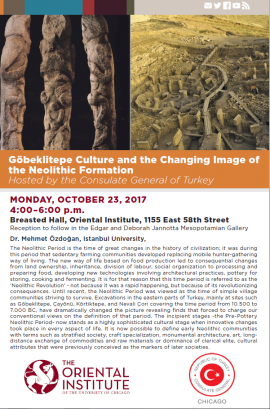Göbeklitepe Culture and the Changing Image of the Neolithic Formation
Mehmet Özdoğan
Istanbul University
Monday, October 23, 2017
4:00-6:00 pm
Breasted Hall of the Oriental Institute
Reception to follow in the Edgar and Deborah Jannotta Mesopotamian Gallery
The Neolithic Period is a time of great change in the history of civilization; it was during this period that sedentary farming communities developed, replacing the mobile hunter-gathering way of living. The new way of life based on food production led to consequential changes from land ownership, inheritance, division of labour, and social organization to processing and preparing food, developing new technologies involving architectural practices, pottery for storing, cooking and fermenting. It is for that reason that this time period is referred to as the "Neolithic Revolution" - not because it was a rapid happening, but because of its revolutionizing consequences. Until recently the Neolithic Period was viewed as a time of simple village communities striving to survive. Excavations in the eastern parts of Turkey, mainly at sites such as Göbeklitepe, Cayōnū, Körtiktepe, and Nevali Cori covering the time period from 10,500 to 7,000 BC, have dramatically changed the picture revealing finds that forced to change our conventional views on the definition of that period. The incipient stages — the Pre-Pottery
Neolithic Period — now stands as a highly sophisticated cultural stage when innovative changes took place in every aspect of life. It is now possible to define early Neolithic communities with terms such as stratified society, craft specialization, monumental architecture, art, longdistance exchange of commodities and raw materials or dominance of clerical elite, cultural attributes that were previously conceived as the markers of later societies.
Hosted by the Consulate General of Turkey


